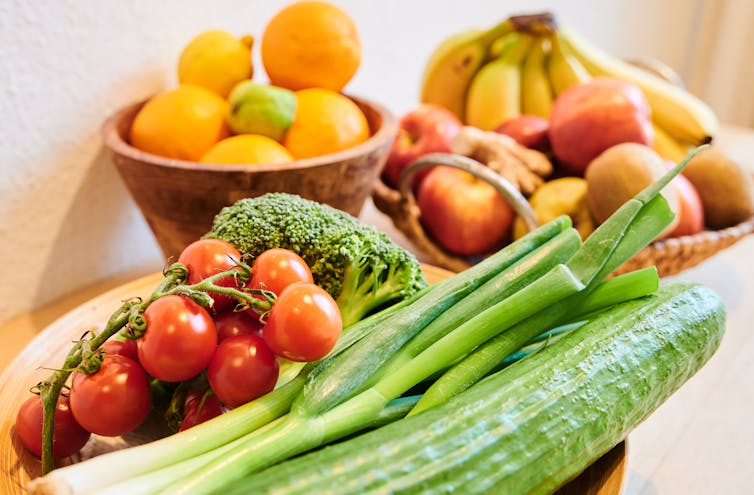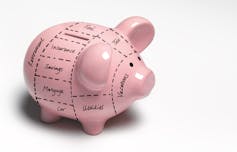Buying groceries isn't a problem just for the poor – middle-class millennials like me with student debt have trouble too
- Written by Cassandra M. Johnson, Assistant Professor of Nutrition and Foods, Texas State University
When I teach undergraduate and graduate students about food insecurity[1], I sometimes mention that my perspective is based not only on professional expertise but also on my personal experience.
Food insecurity might sound like the same thing as hunger, but that’s not the case. The somewhat technical term food insecurity applies when people can’t get the food they need for themselves or their families because of a lack of money or other resources.
Food security[2], on the other hand, is more of an ideal – being able to access culturally preferred foods to support an optimal diet and health. This is my personal take on the gray area between food security and food insecurity – and how student loan debt[3] blurs the line between low-income and middle-income families.
Some 38.3 million Americans [4] – 11.8% of the population – experienced food insecurity in 2020, according to U.S. Department of Agriculture data. Like many other experts, I believe these numbers underestimate the scale of this problem[5]. And that’s not only because it can be hard to detect[6].
One group of Americans who might also be dealing with problems accessing food is middle-class millennials with a lot of student loan debt – like me. Despite being an assistant professor[7] in a double-income household, in my opinion, I am not able to afford the foods I feel my family should be eating.
To be clear, based on the official criteria[8], my family is not food insecure. I’ve never been to a food pantry and my family always gets enough to eat. My family’s frugal diet is packed with nutritional value[9]: beans, white potatoes, sweet potatoes, carrots, broccoli, tomatoes, milk and eggs. In some regards, however, I believe that my family is not fully food secure[10] because our choices are somewhat limited.
Settling for a frugal diet
For example, I know the benefits of eating more fresh seafood[11]. It’s a lean source of protein, packed with heart-healthy fats and full of minerals and vitamins. Plus, I like how it tastes. But it can be expensive.
Fresh fish can cost US$15 per pound or more at my local grocery store in central Texas[12]. That’s far higher than fresh poultry, pork and beef[13]. Canned and frozen fish are much cheaper and last longer. Aside from a few special occasions, I’ll buy large cans of chunk light tuna and frozen packages of mussels and fish. Because price is a limiting factor, I usually stock up on vegetarian sources of protein like beans, legumes and tofu.
Another example is fruit. I don’t buy much fresh fruit in quantity or variety, as recommended by dietary guidelines[14], because of cost. Instead, I rely on a small quantity of seasonal fresh fruit on sale and some dried fruit[15], such as raisins.
I make trade-offs like these in terms of what my family of four wants to eat and what our diet needs to include with every food group the government and nutritionists consider to be part of a recommended dietary pattern[16].
I track items I want to buy based on what we like to eat, the food’s nutritional value or importance for culture. But I buy them only on sale or for celebrations. While I recognize my circumstances and compromises are not the same as those of a family of four with a poverty-level income[17], some experiences – relative deprivation and stress – may be similar.
 Eating plenty of fresh fruit and vegetables is good for your health, but the costs can add up quickly.
Annette Riedl/picture alliance via Getty Images[18]
Eating plenty of fresh fruit and vegetables is good for your health, but the costs can add up quickly.
Annette Riedl/picture alliance via Getty Images[18]
Food insecurity economics
Even though the economics of food insecurity[19] is complex, more nutritious food usually costs more and less nutritious food typically costs less[20].
In pursuit of a healthy diet, low-income families, in addition to receiving assistance such as SNAP, can employ a variety of strategies[21] to spend less money on food. For example, they can use budget-conscious grocery shopping, daily cooking and food prep, reheating and reusing leftovers, packing lunches to eat at work and rarely eating in restaurants or buying takeout foods.
We live with my parents and pay what we used to pay in rent into our savings account so that someday we can buy a house. After paying for housing, utilities, transportation, health care, child care and education, credit card debt and student loans, almost half of what’s left over covers groceries: about $900 per month.
Spending almost half of our disposable income on food is more in line with what happens in low-income households[22], according to the USDA. Households in the lowest, middle, and highest income groups spent about 36%, 20% and 8% of their disposable income on food, respectively, in 2019.
I wonder how many more Americans would be eligible for government assistance if student debt payments were taken into account.
A gray area
The U.S. Department of Agriculture Economic Research Service measures food insecurity through a survey[23] of nationally representative households[24]. One of its questions is:
“Which of these statements best describes the food eaten in your household in the last 12 months?” These are the options:
- Enough of the kinds of food (I/we) want to eat
- Enough, but not always the kinds of food (I/we) want
- Sometimes not enough to eat
- Often not enough to eat
If someone asked me this question on food sufficiency, I would answer without hesitation: We eat enough, but not always the kinds of food I want for myself or my family.
In short, we – and many others making relatively high incomes – don’t meet the official criteria for food insecurity. But we also don’t have the resources to feel food secure.
College debt
Millennials like me are doubly burdened: Our income excludes us from many government benefits, and our needs, because of our student loan payments, leave us with very little disposable income.
I was the first person in my family to graduate from a four-year college and the first to obtain a graduate degree. But my career path came with a cost: Now in my 30s, I’m stuck with $133,000 in student loan debt, most of which I racked up as an undergraduate.
I hustled in my mid-20s to get a series of fellowships and research jobs for my top-ranked doctoral program. All that work made my career dreams come true and meant I could stop borrowing so much to finance my doctorate. But it didn’t make it easier to deal with the challenges of being a first-generation academic[25]. In the past I have resorted to credit card debt to buy groceries and sometimes borrowing money from my relatives. It felt awful and awkward to ask for help with food while earning my doctorate in nutrition.
 People appearing financially comfortable can actually be cash strapped.
Peter Dazeley/The Image Bank via Getty Images[26]
People appearing financially comfortable can actually be cash strapped.
Peter Dazeley/The Image Bank via Getty Images[26]
Other millennial professionals are struggling to make ends meet too. Monthly payments for housing, health and medical care – including health insurance premiums – and transportation leave very little money left for food. Parents, like me, also contend with high child care costs. It’s no wonder that researchers are finding that student loan debt is taking a toll on my generation’s health and well-being[27].
The average American with student loan debt spends about $393 per month servicing it[28].
I shell out nearly triple that much to keep up with my loans. It’s the equivalent of a mortgage payment, and one-third of what I earn. My college loan payments will soar in December when the COVID-19 relief for federal student loan payments[29] expires in tandem with regularly scheduled increases[30]. My husband’s student loans are smaller, but it’s another bill we contend with.
While it can be frustrating to feel that the food I want for my family remains out of reach, I do realize that we are the lucky ones. I know how to shop, cook and eat on a budget and make sure my family eats a variety of nutritious and tasty meals on a regular basis. Many others in this situation don’t have what they need to cope with it.
References
- ^ food insecurity (theconversation.com)
- ^ Food security (www.ers.usda.gov)
- ^ student loan debt (www.investopedia.com)
- ^ 38.3 million Americans (www.ers.usda.gov)
- ^ underestimate the scale of this problem (doi.org)
- ^ it can be hard to detect (doi.org)
- ^ assistant professor (scholar.google.com)
- ^ official criteria (www.ers.usda.gov)
- ^ nutritional value (doi.org)
- ^ food secure (www.ers.usda.gov)
- ^ eating more fresh seafood (www.doi.org)
- ^ my local grocery store in central Texas (www.heb.com)
- ^ poultry, pork and beef (www.bls.gov)
- ^ dietary guidelines (www.dietaryguidelines.gov)
- ^ dried fruit (www.heb.com)
- ^ recommended dietary pattern (www.dietaryguidelines.gov)
- ^ poverty-level income (aspe.hhs.gov)
- ^ Annette Riedl/picture alliance via Getty Images (www.gettyimages.com)
- ^ food insecurity (www.jstor.org)
- ^ more nutritious food usually costs more and less nutritious food typically costs less (www.ers.usda.gov)
- ^ variety of strategies (pubmed.ncbi.nlm.nih.gov)
- ^ what happens in low-income households (www.ers.usda.gov)
- ^ measures food insecurity through a survey (www.ers.usda.gov)
- ^ nationally representative households (www.ers.usda.gov)
- ^ being a first-generation academic (www.insidehighered.com)
- ^ Peter Dazeley/The Image Bank via Getty Images (www.gettyimages.com)
- ^ toll on my generation’s health and well-being (theconversation.com)
- ^ $393 per month servicing it (educationdata.org)
- ^ COVID-19 relief for federal student loan payments (www.consumerfinance.gov)
- ^ regularly scheduled increases (studentaid.gov)

















